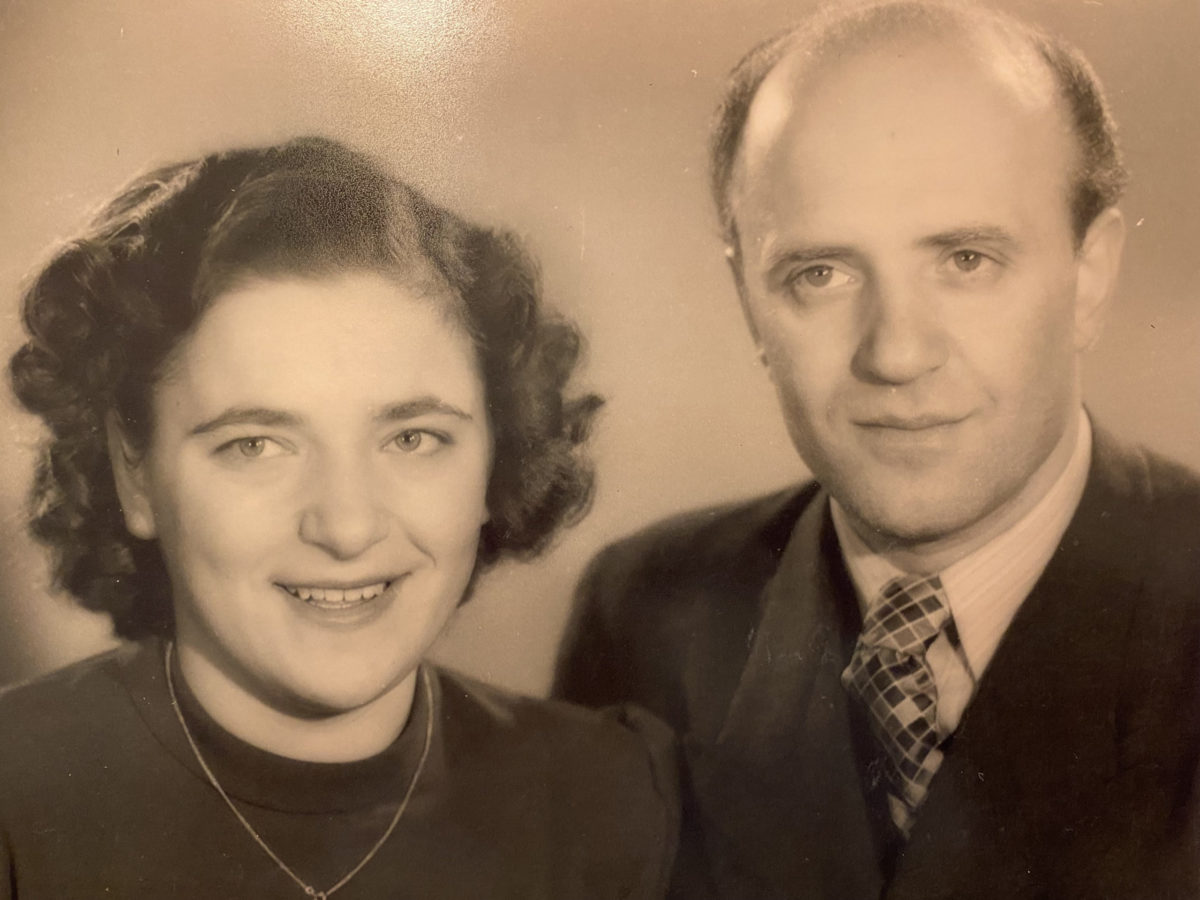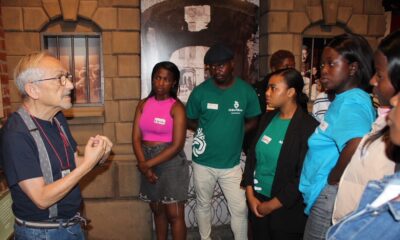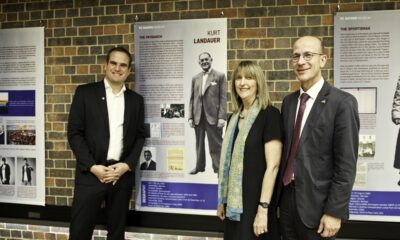
Community

The miracle of the maroon handkerchief
Seventy-eight years ago, a Jewish man gave his 17-year-old daughter a maroon handkerchief as a way to remember him. She never saw him again – he died in the Holocaust. But she survived, went to America, and recorded her testimony in 1984.
Fast forward to 2020, and 14-year-old King David Linksfield pupil Noa Nerwich is asked to write a poem for a competition based on a Holocaust survivor’s testimony. She came across Ruth Halbreich’s recording, which includes mention of the handkerchief. Nerwich wrote a poem about the handkerchief and won the competition.
A year later, Halbreich passed away. Shortly thereafter, her grandson, Reg Tigerman, came across the poem in a newsletter he received, and realised it was about his grandmother. But that’s not all: soon after that, he also found the maroon handkerchief. He made contact with Nerwich [who is now 15], bringing a story that has spanned generations and continents full circle.
Speaking to the SA Jewish Report from Los Angeles, Tigerman says, “When I discovered the poem, I was shocked. Ruth, who we affectionately called Nanny, had just passed away a few months ago. The maroon handkerchief had been a topic of conversation within our family because my wife and I revisited her testimony right after she died and talked about trying to find it.
“My mom, who was going through Nanny’s things, did end up finding it. So, not only did Noa write a poem inspired by my grandmother’s testimony, which is an honour in and of itself, but she picked up on an item she mentioned at the very end of her testimony (proving that Noa was paying very close attention), and it was something that a lot of time and attention had been spent on recently. It was a series of dayenus [it would have been enough]. A true miracle. It felt like the world was telling us how important Ruth and her story is, and how important it is to continue to share her story.”
According to the United States Holocaust Memorial Museum, Halbreich was born in 1926 in Warsaw to a well-to-do family of three sisters and one brother. In 1939, their father fled with them to the Russian part of Poland, where he continued his work in the paper business. She, her father, and one sister crossed back into Warsaw, but her mother and two other siblings were sent to Siberia.
Halbreich and her family moved into the Warsaw ghetto in 1940. When the Germans started sending people from the ghetto to the camps, she and her sister were sent outside the ghetto to live in a convent. After the Warsaw ghetto uprising, Halbreich and her sister were sent to a slave labour camp in a small town in Germany. They were liberated in April 1945. She found out that her father had died in the ghetto in 1943, fighting in the underground. She met her husband, a fellow Holocaust survivor, at a displaced-persons camp. She also found out that her mother and two siblings had survived in Siberia.
In her testimony, Halbreich says, “The uprising was in April 1943. My father had left the ghetto in the trucks carrying merchandise. I met him in his office. He gave me a handkerchief of his to remember him by. My father’s biggest wish was to be able to save his children, and he was able to do this. He went back into the ghetto, and no one really knows what might have happened to him.”
A million miles away from that time and place, Nerwich entered the 21st Annual Holocaust Art & Writing Contest run annually by Chapman University and The 1939 Society (a community of Holocaust survivors, descendants, and friends). “The brief was for a piece of creative writing based on the testimony of a Holocaust survivor,” she told the SA Jewish Report.
The poem describes the handkerchief as the only thing Halbreich has left from her father as her world is destroyed, and how it symbolises the flames of destruction and her father’s deep love.
“Hearing her story and writing the piece itself was an enriching experience,” says Nerwich. “I was thrilled when I was awarded first place, a first for King David High School. I always smile just thinking about my poem. However, a small part of me always wished that Ruth would be able to read the poem and know that her story is being shared, that she is being heard.”
So, when she received the email from Tigerman on 15 July, “it changed my life. I read it and re-read it because I was sure my eyes were deceiving me,” says Nerwich.
She was shaking as she read the email. “I felt a deep sense of loss to learn that Ruth had passed away, but I was also deeply moved to learn that her family had the gift of this poem and that Ruth’s story continues to be told. Seeing the actual picture of the maroon hankie – the last memory that Ruth had of her father, the piece of fabric that guided her throughout the horrors she endured – is an image that will be permanently engraved in my mind.”
She says she chose to reflect on this story in her poem “because I could relate to Ruth. I’m a very sentimental person. Just like Ruth’s dad gave her a red handkerchief, my dad made me red roses out of Lego, which I keep in my room. So, the fact that she mentioned the maroon handkerchief that her dad gave her really resonated with me. It made it so much more real. It’s a symbol of her story, and what she and so many others went through.”
Her mother, Daniella Nerwich, says she felt breathless when she read Tigerman’s email. “All this really shows the value of Jewish education. We are so fortunate that King David creates opportunities like this [to enter the poetry contest]. This just shows how it can be so far-reaching. So huge credit must go to King David for creating this opportunity. It has been life changing.”
Because of the pandemic, Nerwich was unable to travel to the United States to collect her prize, but Tigerman’s message has made up for that disappointment. They hope to meet in person one day, and possibly even work together to share the story of the maroon handkerchief as a form of Holocaust education.
Says Tigerman, “While my grandmother didn’t often share her story (she would if you asked, but she wasn’t very proactive about it), my grandfather [Siegfried Halbreich] was a regular speaker. He was a survivor of multiple concentration camps over the course of five and a half years. He served as president of The 1939 Society, the organisation that published Noa’s poem, and was a founder of the Los Angeles Holocaust Museum. Everyone’s story is worth telling and remembering, which has made the oral histories and recorded testimonies so important.”
A maroon hankie
“Cleanly pressed and folded it was placed into my hand
A last token of a soon to be memory
I received a maroon hankie
I didn’t know the value of objects, until I had one
I didn’t know the value of people, until I had none.
But my one object carried all the worth in the world
A maroon hankie
I don’t know what happened to him
All I know is the walls were rising
And there were bombs, more people dying
and Warsaw was in flames: Red, licking flames
Like the colour of my maroon hankie
We watched from the window, havoc unleashed on our home
Yet we were the opportune, we were on the right side of the window pane
The side where we still wore silky dresses made by the sisters.
the same silk of my maroon hankie
I was lucky
not because I was saved
But because I learned the true meaning of love
His love was sewn into my heart
The same way I held the hankie so tight at night
That its fibers have sewn into the fibers of my skin
Because of my father’s honour I survived
Because of his love for us he died
He sacrificed it all so we could breathe the air of freedom
To the man who gave to me
The thing that has carried all of my tears
A maroon hankie
His maroon hankie”










